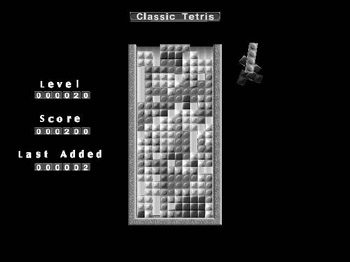Tetris as a Classic Arcade Game
There are many indications that Tetris is an example of what I call the classic arcade game form. This is despite the fact that it was not originally conceived for gameplay in the arcades (though its rampant popularity eventually led to its arrival there), and that it was created years after the classic arcade game form had stopped being used by professional arcade game developers. Looking over the list of classic arcade game qualities described in the Centipede analysis in Chapter 4, we can see just how Tetris fits the guiding principles of the form.

Despite being developed years after classic arcade games had fallen out of style, Tetris s gameplay embodies many of the design principles of that genre of games.
-
Single Screen Play: Of course, Tetris takes place on only one screen. Players are able to view the entire game-world at one time and make informed decisions about what they want to do with a given piece based on that. There is no exploration component to the game, no way to really surprise players (beyond what piece appears next ), so players have all the information they need to be successful at the game, and have nothing to blame but themselves for failure.
-
Infinite Play: Tetris allows players to keep playing until, through their own bad decisions, the blocks reach the top of the box. Every game ends in defeat, and no one can truly say they have beaten the game. Players can always find ways to improve their Tetris playing ability. This is a crucial difference between Tetris and a traditional puzzle. Once players have solved a puzzle, if they remember how they did it the first time, the puzzle will no longer present any challenge to them. People usually do not enjoy doing puzzles multiple times, whereas a well-designed game can be replayed forever. Tetris is just such a game.
-
Multiple Lives: Unlike most classic arcade games, the original Tetris implementation only offers players one life. Once the blocks reach the top of the box, the players game is over. The design of the game, however, allows players to see that they are doing poorly while not defeating them instantly. As the blocks stack up at the bottom of the rectangle, players see the mistakes they are making and have time to figure out how to better line up the blocks before their game is over. So, while Tetris does not offer players multiple lives, it does give them a chance to learn the game well enough to achieve some minor successes before forcing them to start over.
-
Scoring/High Scores: Tetris uses a model for giving players a score and recording it in a high-score table, which is directly taken from the system used in games like Asteroids or Galaga . Indeed, since the game cannot be defeated, it is the possibility of achieving a higher score that can become the players true impetus to play the game again.
-
Easy-to-Learn, Simple Gameplay: Tetris truly excels in how simple and obvious its game mechanics are. Players really only need three buttons in order to play the game successfully, and these all translate into obvious results on the screen. This means that virtually anyone , regardless of how familiar they are with computer games, can walk up to the game and start playing it immediately. However, players will never be able to fully master the game due to the game s ramping -up difficulty and the potential for infinitely long games.
-
No Story: Tetris has even less story than most classic arcade games, and is the case most often cited by people who want to point out that games do not need stories to be compelling for players. The only sort of setting Tetris has is its origins in Russia, which has been used for various aesthetic effects in the different incarnations of the game. The first PC version of the game, as published by Spectrum Holobyte, included backdrops behind the gameplay that involved different scenes from Russian life, and the music sounded vaguely Slavic in origin. But once people learned what a great game Tetris was, subsequent implementations of the game, such as the one for the Nintendo GameBoy, had no Russian theme to them and had no setting or story at all. The game did not suffer one bit for this lack of story. Indeed, Tetris s total lack of setting may actually be something that separates it from the classic arcade games, which all made an attempt to be grounded in a fantasy world of some sort, whether it was outer space in Galaga , insects in a garden in Centipede , or funky ghosts chasing a little yellow man around in Pac-Man. Tetris has no such pretensions, and thus stands out.
EAN: 2147483647
Pages: 189